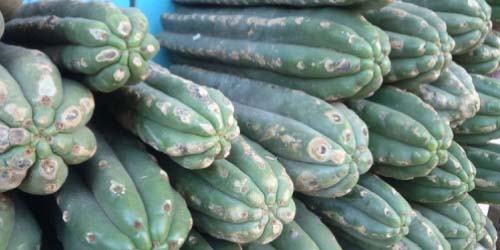
How you ever had the feeling of being unsure whether you’re still dreaming or are awake? A mescaline trip from the Peyote or San Pedro cactus can do that to you. We dive into the cactus trip in this article and explain what you can expect and how you can best prepare your cactus.
Peyote
Eat a cactus? Isn’t that going to be painful? Not all cacti have spines. Peyote (Lophophora williamsii) is one such cactus. The slow-growing, spherical-shaped peyote has a whole range of psychoactive substances which let you hallucinate and experience reality differently. One of these substances is mescaline, a natural hallucinogen which turns the world on its head. Peyote contains some 3 to 6% mescaline.
The nice thing about peyote or other mescaline cacti? You can buy or grow them yourself and then use them. It takes a while before you have a mescaline cactus that is ready to use, but once fully grown they can provide an unprecedented experience. You want to trip on mescaline the easy way? Then go for a full-fledged San Pedro cactus cutting.
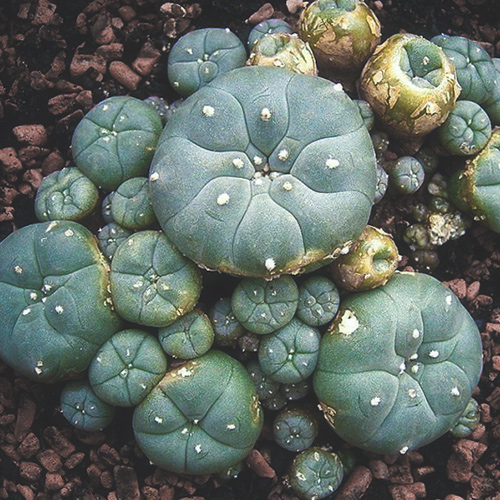
This grey-green cactus is actually a Tex-Mex plant. It can be found in the southern United States and Mexico. The plant is ribbed and forms a beautifully pink, white or yellow flower at its heart. The peyote is usually quite small (up to 12 cm in diameter) but there are exceptions which we will discuss later.
Endangered Species
Another thing you should know about the cactus itself is that it’s on the red list of protected species. Peyote is being picked faster than the cactus can grow back. That’s making it more and more rare in nature.
The fact that there’s less around has partly to do with increasing recreational use and is also due to religious use. In the U.S. the use of peyote is allowed if you’re a member of the Native American Church. The plant has been used for shamanistic purposes since time immemorial. From carbon-dating we know that the original inhabitants of North America have known about the effects of eating this particular cactus for the last 5,500 years.
Tripping on Peyote: Dosage and Use:
But how do you prepare the cactus for consumption? A normal dosage of mescaline is around 300 mg. 20 grammes of dried peyote contains roughly this dose. Eating this amount will provide a trip of average intensity. 15 grammes is a milder trip and 30 grammes will send you on a heavy trip. In this sense the dosage is no bigger than with Magic Truffles. The difference lies in the drying process. Magic Truffles are not eaten in dried form.
Just like with truffles, you can brew peyote tea. Allow 20 grammes of dried peyote to dissolve in a cup of water that is just off the boil for best results. Would you prefer not to dry them? Then you need 150 grammes of fresh peyote for a mild trip. But we do not recommend it. Peyote is not particularly pleasant. It tastes extremely bitter. Often you feel sick before the trip phenomena start to kick in.
San Pedro
While Peyote is known for being slow-growing, San Pedro is a rather fast-growing cactus. San Pedro (Echinopsis pachanoi) originates in the high Andes mountain range. Countries it can be found in include Chile, Bolivia, Ecuador and Peru. Mescaline-bearing cacti have also been in use there for shamanistic and religious purposes for a long time.
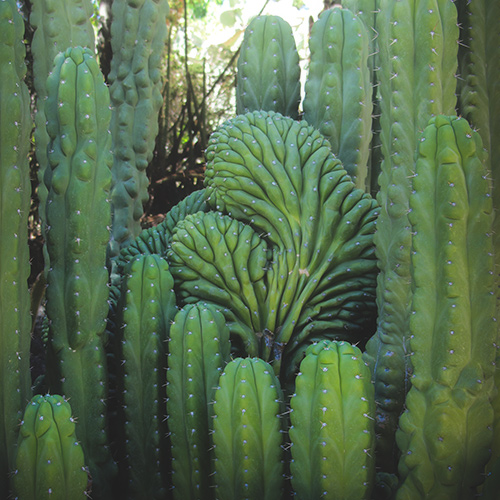
The San Pedro come in all kinds of colour shades. From greenish-yellow to greenish-blue. It is said that the blue colour is the result of an accumulation of hallucinatory substances. But there again, it’s also reckoned to show that there’s a nutrient shortage in the cactus soil.
A stem is some 6 to 15 centimetres in diameter and a full-grown cactus can be as much as 6 metres in height. Sometimes the San Pedro has no spines, but usually it does. That makes the preparation of San Pedro a bit trickier.
Apparently (anecdotal evidence) the outer layers of the San Pedro contain more mescaline. Remove the spines and peel around the cactus. Let the peel dry.
Tripping on San Pedro: Dosage and Use:
If you are into a trip on mescaline, you can easily buy a San Pedro cactus cutting from us. It’s not easy to tell how much active substance a San Pedro contains. 50 grammes of dried San Pedro could contain 150 mg of mescaline or a veritable 1200 mg. So start off with a very low dosage (7 grammes of dried peel) from the same cactus to test how intense the trip is. This will avoid a potential overdose. A week later you can maybe try a bit more. Double the dosage if you still haven’t noticed any effect. It is important to go through these steps for each harvest.
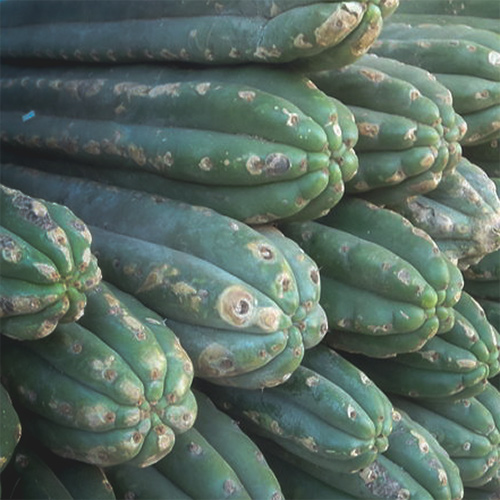
You can also brew tea with San Pedro. Soak some 7 to 20 grammes of dried peel in hot water and sieve the peel later from the water.
A Mescaline Trip: What does that feel like?
Within thirty minutes a feeling of queasiness begins. Sometimes this is coupled with sweating or cold shivers but this will pass of its own accord as the trip begins. After one to two hours you experience a feeling of calm and acceptance. The peak of the trip is reached between 2 and 4 hours after dosing and the effects slowly recede during a period of 8 to 12 hours thereafter. The total duration of the effects of a peyote trip is a maximum of 16 hours. A higher dosage can prolong the trip. For up to 24 hours.

The effects are comparable to those of LSD. You can expect to experience mood swings, increased emotions and, of course, a change in perception. Ideas about self-awareness, time and reality will also be turned on their heads as it seems like you are one with the universe. Your environment can ‘melt’ or ‘breathe’ making it appear as if everything lives and is connected together. In some cases a peyote experience can be transcendent. That is to say that you will entertain radically different ideas on a trip from those you had before.
In chemical terms, mescaline resembles 2C-B, a synthetic trip drug. In the same way as LSD, DMT, 2C-B and psilocybine, the psychoactive component in Magic Truffles, mescaline works on the serotonin receptors (especially 5-HT2A) in the brain.

Are there any Risks? And are these Cacti Addictive?
As with all psychedelic substances it is sensible to use them in a familiar environment accompanied by a sober trip sitter. Do not drive and keep windows and doors shut. By their nature, peyote and San Pedro work brilliantly on the senses. Colours become deeper and the forms of leaves and flowers make a trip even more intense.
What you must not do is to combine mescaline cacti with:
- Alcohol and cannabis.
- Drugs that pep you up like cocaine and amphetamines.
- Tramadol.
- Depression, anxiety or psychosis.
- MAO inhibitors such as Banisteriopsis, sedatives and medicines.
- Medication for heart conditions or for lowering high blood pressure.
- Do not use if pregnant or breastfeeding.
Cacti such as peyote and San Pedro, and also the peruvian torch, are not addictive. You will quickly build up a tolerance which needs a few days to recover from. That means you have to take more cactus to achieve the same effect.
The biggest drawback of peyote and San Pedro is that they can make you nauseous. Be sure to keep a bucket handy and some bottles of water just in case. Only take this kind of cactus trip when you feel well - then the experience will be pleasurable. Peyote and San Pedro enhance how you are feeling. If you’re feeling down then a trip is not the answer to the problem!
There are also cacti in circulation which strongly resemble San Pedro but don’t contain any hallucinatory substances. The cacti are mostly harmless but all they are is a nice decoration for the house.
Cultivating Peyote or San Pedro Yourself
Cultivating these cacti yourself is pretty easy and great fun. Cactus cultivation is a world to itself. You’ll discover that you can have magnificent plants which need hardly any looking after and that there are bizarre forms of growth known as crests.
Crest (or cristation)
A San Pedro or Peyote with a cristate form is truly a collector’s item. The fascinating forms which the cactus can take on make you want to keep looking at it. Have a look at the following photographs and see if you’re tempted.
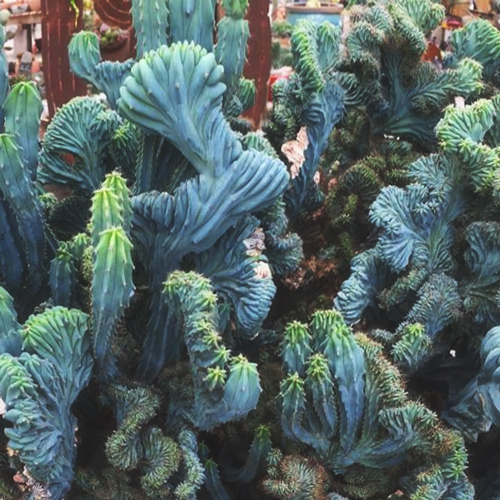
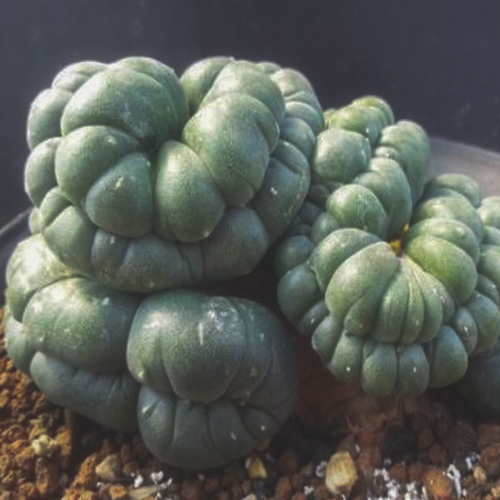
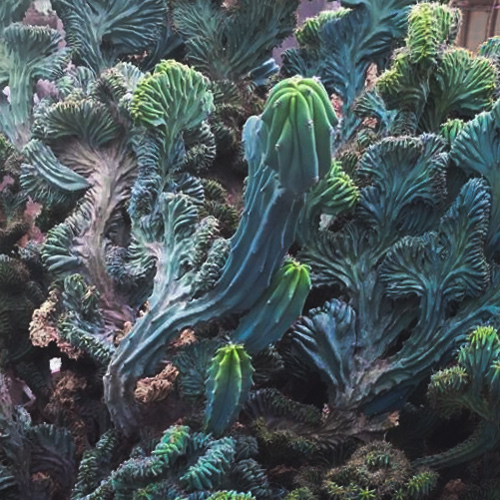
It's difficult to say how you can cultivate this form. Some people claim that it’s genetically determined while others maintain that external factors are responsible for giving cacti crest shapes. A cactus seed in your order might just grow into this kind of magnificent form.
Would you like to know more about cultivating mescaline cacti? Then take a look at our category for San Pedro and Peyote seeds. Do you want more information about mescaline cacti? Check out our other blogs about them: